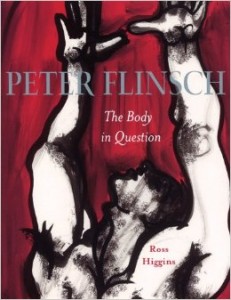 Peter Flinsch: The Body in Question
Peter Flinsch: The Body in Question
by Ross Higgins
Arsenal Pulp Press
175 pages, $27.95
BASED IN MONTRÉAL, painter Peter Flinsch, now 88, has been renowned among art critics and historians for decades, having had major shows in Berlin and New York, among other cultural centers. But he remains unknown to people in the queer community—a status that has been begging for a remedy.
And here it is. Captured in beautiful reproductions, over 100 of Flinsch’s paintings, sketches, and sculptures are gathered in Peter Flinsch: The Body in Question, a much-needed anthology of the artist’s tremendous contribution to gay erotica. This collection is elucidated by historian Roy Higgins of McGill University, who proves himself equal to the task. Made up of equal parts biography and analysis, Higgins’ essay places Flinsch’s œuvre into its historical and political context.

Flinsch is known as much for the variety of his output as for its sheer volume. Some of the drawings are ostensibly simple, evoking the works of Jean Cocteau. Others are more brazenly libidinous, recalling Tom of Finland. Flinsch’s art is unmistakably that of a gay man’s imagination, though many are specifically rooted in Québec, which was, as it happens, the first region in North America to have legislative human-rights protection for gays and lesbians (established in 1977). All of his works are decidedly erotic, alive with worship of the male physique and often of the groin area. Flinsch has been working steadily on his art since the 60’s. (Suffice it to say, neither Anita Bryant nor Jesse Helms was ever a fan.)
As pleasurable as Flinsch’s work is, his life story—evocatively rendered in Higgins’ text—is simply astonishing. During World War II, he was recruited (as all young German men were) into the Nazi military. During a Christmas party in 1942, he was spied planting a kiss on another officer. That led to his being interrogated by Nazi police, submitting to a confession, and being placed in a Nazi prison for over a year during the war. During his detention, Flinsch was forced to openly state, in front of all the other inmates, that he was being imprisoned due to his homosexuality. Every morning he would make this crushingly humiliating announcement. But ironically, Flinsch now credits that experience with his audacity as an artist. In a sense, since that time Flinsch felt he had nothing left to lose. As Higgins notes, “Peter’s wartime arrest made his sexual identity paradoxically less problematic for him than for [other]men … who never had to confront it so brutally.”
The Body in Question is a long overdue testament to the power of Peter Flinsch’s art, and one anticipates that this book will help to bring it to the attention of many more people. There’s also a pleasing arc to the book: thumbing through it, one gets the sense of a gentle reflection on the gay liberation movement itself. Flinsch, after all, made the journey from a Nazi gulag to a stunning apartment in downtown Montréal in a country that now offers full equality to its GLBT citizens, including same-sex marriage. It’s a suitable place for Flinsch, who continues to paint, draw, and sculpt, to have settled—a pioneer who persevered through the most repressive of times. This book is a fitting retrospective for an artist in the twilight of his career, telling an inspirational story about the power of art and the survival of a persecuted artist.
Matthew Hays teaches film studies and journalism at Concordia University in Montreal, and is the author of The View From Here (2008).






